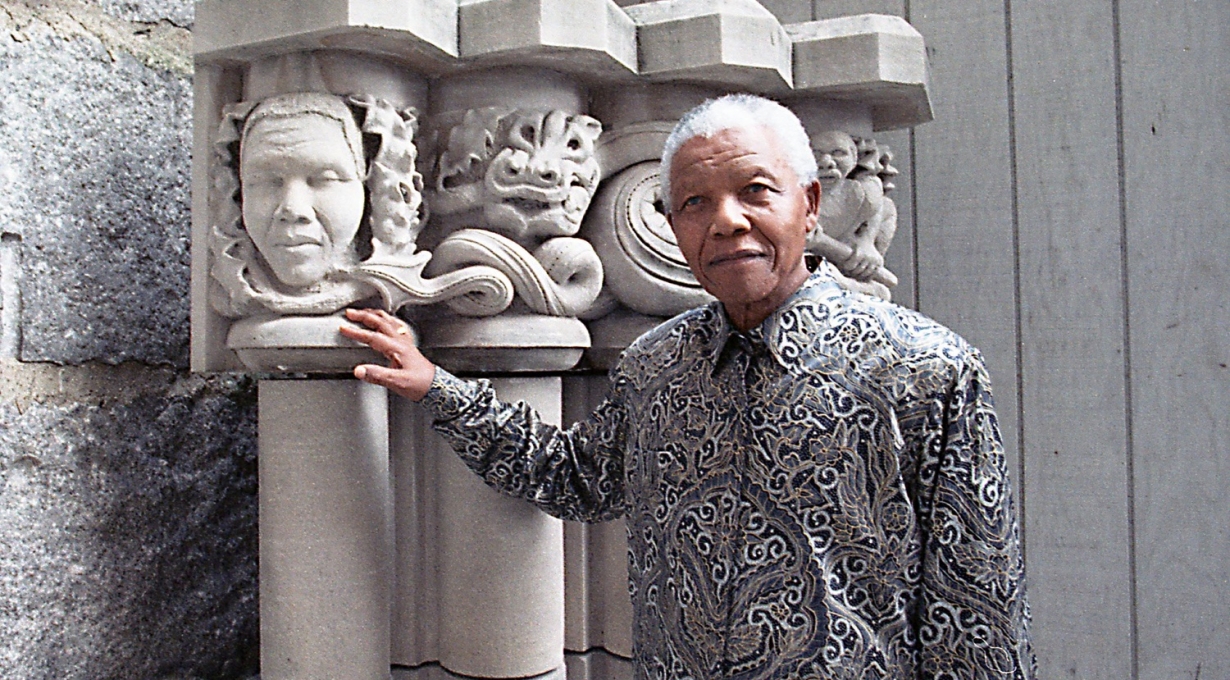Nelson Mandela at the Cathedral

Nelson Rolihlahla Mandela (July 18, 1918 – December 5, 2013, President of South Africa 1994 - 1999) is a global icon and the embodiment of persistence and the spirit of reconciliation. In South Africa, Mandela is celebrated as "the father of the nation."
Mandela visited the Cathedral in 1998 and is pictured here with a sculpture of his likeness carved by Emmanuel Fourchet. To the right of Mandela’s face in the stone, a spear-wielding warrior stands. Between them coils a dragon, representing apartheid, and by association with the serpent in the Garden of Eden, suggests that the racism underlying the apartheid system is a form of original sin. The Zulu warrior who combats the dragon with his spear may be seen as a reference to the Spear of the Nation movement, uMkhonto we Sizwe, which Mandela cofounded in 1961 to overthrow apartheid.
Mandela had hoped that something like the Spear of the Nation movement would never have been necessary, because it organized sabotage attacks against South Africa’s apartheid government, which ran counter to his belief in non-violent protest. However, he perceived no alternative to compel South Africa’s government into negotiations. He had previously devoted his life to combating injustice through the legal system and through politics, training as a lawyer and joining the African National Congress in 1943. A decade later he opened the first African-operated law firm in the nation, Mandela and Tambo, and specialized in cases of police brutality.
His connection to uMkhonto we Sizwe led to his conviction in 1964 of sabotage and conspiracy to violently overthrow the government. His death sentence was commuted to life imprisonment. He was incarcerated for twenty-seven years and, through perseverance and unbreakable resolve, became one of the most celebrated political prisoners on earth. The contrast between his brutal treatment and his own nonviolent conduct helped bring down apartheid. In 1990, South African President F. W. de Klerk released him.
Rather than seek vengeance, Mandela sought reconciliation. Shortly after his release, he toured the world, meeting heads of state to generate support for full democracy in South Africa. In 1993, he and de Klerk jointly received the Nobel Peace Prize, and the following year, Mandela was elected president of South Africa with de Klerk as deputy president. On assuming office, he created the Truth and Reconciliation Commission, chaired by Anglican Bishop Desmond Tutu, which became a model for resolving lethal conflict between antagonists.
After his departure from the presidency and politics, Mandela campaigned to fight HIV/AIDS in Africa and for peaceful resolution to conflicts. He died on December 5, 2013 at the age of 95 from a respiratory infection.
The Cathedral’s sculpture of Mandela originally was intended to ornament the southern bell tower, but that remains uncompleted, so the portrait remains in the nave where it may be seen up close by all visitors. Emmanuel Fourchet was aged only twenty-four at the time he carved it, and he continued to develop his craft. In 2010 he engendered controversy by incorporating the face of his friend and colleague, Ahmed Benzizine, into a gargoyle on the Cathedral of St. Jean in Lyon where both had worked together for years. Benzizine is Muslim, and beneath the gargoyle reads an inscription in both French and Arabic, “God is Great”.